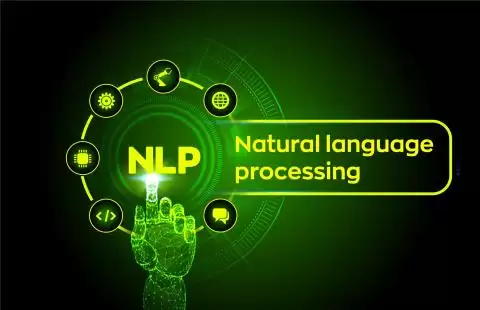This blog explores the exciting advancements in the Natural Language Processing (NLP) field and its potential impact on our lives and society. With the advancement of artificial intelligence (AI) technology, many believe that conscious computers are just around the corner.
This blog will delve into the latest developments in NLP and their potential to revolutionize how we interact with technology, changing it from a tool we use to a conscious entity that can understand and respond to human emotions and language. Let’s explore the possibilities of conscious computers and the future of Natural Language Processing.
How Does Natural Language Processing Work?
NLP is an artificial intelligence field that deals with how humans and computers interact through natural language. It involves speech recognition, sentiment analysis, machine translation, text generation, etc. It works by breaking down the input language into smaller components, such as words and phrases, and then using statistical models and machine learning algorithms to analyze and understand the meaning behind the language.
The future of Natural Language Processing seems brighter. The process typically involves tokenization, stemming, part-of-speech tagging, named entity recognition, parsing, semantic analysis, and generation of a response. The output is generated based on the analyzed input, ranging from a simple response to a more complex task, such as translation or summarization.
NLP models are trained on large datasets to improve their understanding of human language and to generate more accurate outputs. The quality of the output is heavily dependent on the quality of the training data and models used.
Different Elements of NLP

Natural Language Processing (NLP) consists of many elements that enable computers and machines to understand human language. These elements include syntactic analysis, semantic analysis, language models, sentiment analysis, and machine translation.
- Syntactic analysis is the process of analyzing how words are arranged in a sentence and how they relate to each other.
- The semantic analysis looks at the meaning of words, their relationships to one another, and their contexts.
- Language models use statistical techniques to identify patterns and infer meaning from written or spoken language.
- Sentiment analysis looks at the emotions expressed in a text and attempts to assign a numerical value to it.
- Finally, machine translation takes input from one language and converts it into another language automatically.
AI development companiesHire Machine Learning Expertsto utilize these components of NLP to develop applications for both consumers and businesses.
Natural Language Processing with Python is particularly popular because it offers a range of libraries and frameworks that make it easier to develop sophisticated AI systems. For example, NLTK (Natural Language Toolkit) is a popular open-source library used to build language processing systems using Python.
Furthermore, Google’s TensorFlow library provides high-level APIs for building advanced machine learning models. Together, these tools help developers build powerful AI applications that can interpret and understand human language.
Recent Developments in NLP
Recent advances for the future of Natural Language Processing have enabled exciting new capabilities in Artificial Intelligence (AI).
- Pretrained Language Models: Large, deep learning models such as BERT, GPT-3, RoBERTa have shown remarkable performance on NLP tasks and are widely used.
- Multi-modal NLP: Incorporating other sources of information like images, videos, and audio to enhance language understanding.
- Transfer Learning: Reusing pre-trained models on similar tasks with fine-tuning to save on training time and resources.
- Explainable AI: Improving the interpretability of NLP models to increase transparency and trust in their predictions.
- Cross-Lingual NLP: Developing models that can handle multiple languages and perform tasks such as machine translation.
- Adversarial Attacks and Defenses: Improving the robustness of NLP models against malicious inputs designed to mislead the model.
- Interactive NLP: Developing conversational AI systems that can engage in human-like dialog.
- Augmented Reality and NLP: Integrating NLP technology into AR systems to enable more natural human-computer interaction.
All these recent developments are leading to the massive potential for the future of Natural Language Processing, and AI development companies are well-positioned to take advantage of them.
How will NLP Improve in the Future?

NLP has made great strides in recent years, and this trend will continue in the future of Natural Language Processing. With the help of anArtificial Intelligence Development Company, the current state of NLP technology is likely to improve even further.
Future improvements in NLP are likely to include:
- Improved Pretrained Models: Development of models with higher capacity and better performance on a wider range of tasks.
- More Advanced Multi-modal NLP: Integration of more diverse sources of information for the future of Natural Language Processing and enhanced language understanding.
- Increased Explainability: Further progress in making NLP models more transparent and interpretable.
- Advancements in Cross-Lingual NLP: Improved multilingual text handling and better performance on cross-lingual tasks.
- Robustness to Adversarial Inputs: Development of NLP models with enhanced resistance to malicious inputs.
- Human-like Conversational AI: Continued progress in making NLP-based conversational systems more natural and engaging.
- Integration with Emerging Technologies: Integration of NLP with technologies such as AR, IoT, and quantum computing to expand its applications and capabilities.
- Focus on Ethical and Social Implications: Addressing ethical and social implications of NLP, such as data privacy, bias, and accountability.
The future of Natural Language Processing is exciting, with many opportunities for improvement. With the help of AI development companies, we can look forward to machines that understand human language and can interact with us on a conversational level. This could revolutionize how we interact with machines and lead to a range of new applications.
Conclusion
The future of Natural Language Processing holds immense potential for enabling more natural and effective communication between humans and computers. With ongoing advancements in AI and an increasing amount of text data being generated, NLP has the potential to revolutionize various industries and provide valuable insights for decision-making.
However, it also raises important ethical and social implications, such as data privacy, bias, and accountability, that need to be addressed for responsible and effective use. The field of NLP is rapidly evolving; let’s look forward to seeing how it will shape the future of technology and impact our daily lives.
 Emma Jhonson is a business consultant and technical expert, a passionate writer, who is working withValueCoders– a software development company for nearly 13 years. She holds in-depth knowledge of IT outsourcing and custom software development services. |
